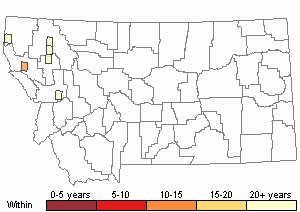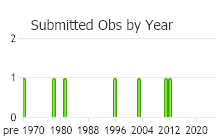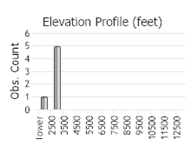View in other NatureServe Network Field Guides
NatureServe
Montana
Utah
Wyoming
Idaho
Wisconsin
British Columbia
South Carolina
Yukon
California
New York
An Antitrichia Moss - Antitrichia californica
General Description
Plants: Pleurocarpous (Vitt 1988), growing in wide-spreading mats, shiny, deep green when dry, bright green when wet (FNA 2014), or may be yellow-brown (Lawton 1971). Secondary stems ascending, more or less evenly pinnate, up to 10 cm in length; lateral branches to 1.5 cm in length, subequal, narrow and whip-like distally, sometimes fertile or producing branchlets up to 5 mm (FNA 2014).
Leaves: Stem leaves catkin-like (from leaves flattened to stem and overlapping) when dry, erect-spreading when wet, lanceolate to ovate (FNA 2014), 2-3 mm in length; margins extremely revolute almost to apex (Lawton 1971), the apical portion serrulate or severely (long) toothed; apex acute to acuminate; costa reaching almost to the apex, lacking or with 1-3 supplementary costae on both sides consisting of 6 or fewer cells. Branch leaves similar to but smaller and narrower than stem leaves, catkin-like and revolute when dry, erect-spreading when wet (FNA 2014).
Leaf Cells: Stem leaf cell walls with few or no pores, smooth; medial cells wavy and linear; alar cells nearly square to transversely rectangular. Perichaetial leaves have thin-walled, rectangular basal cells, 4-5:1, and wavy, elongated medial cells, 5-8:1 (FNA 2014).
Diagnostic Characteristics
The revolute leaf margins and lack of a single strong costa are good field identification attributes for Antitrichia (Vitt 1988).
Range Comments
Canada: BC; USA: AK, CA, ID, OR, WA; s Europe; sw Asia; n Africa; Atlantic Islands (FNA 2014). In Montana, known from Flathead, Lake, Lincoln, Meagher, Park, and Sanders Counties (Elliott 2016).
Observations in Montana Natural Heritage Program Database
Number of Observations: 17
(Click on the following maps and charts to see full sized version)
Map Help and Descriptions
Relative Density

Recency



 (Observations spanning multiple months or years are excluded from time charts)
(Observations spanning multiple months or years are excluded from time charts)
Habitat
In full sun to some shade (FNA 2014), on rotten wood, organic soil, humus and rock at low to moderate elevations (Elliott 2016).
Reproductive Characteristics
Dioicous. Seta 8-11 mm tall. Capsule extending beyond the perichaetial bracts, upright, more or less cylindric, 2.5-5 mm in length (FNA 2014).
Stewardship Responsibility
References
- Literature Cited AboveLegend:
 View Online Publication
View Online Publication Elliott, J.C. and A.K. Pipp. 2018. A Checklist of Montana Mosses (1880-2018). Updated 3 January, 2020. Montana Natural Heritage Program, Helena, Montana. 73 pp.
Elliott, J.C. and A.K. Pipp. 2018. A Checklist of Montana Mosses (1880-2018). Updated 3 January, 2020. Montana Natural Heritage Program, Helena, Montana. 73 pp. Flora of North America Editorial Committee, eds. 2014. Flora of North America North of Mexico. Volume 28. Bryophytes: Mosses, Part 2. Oxford University Press, Inc., NY. xxi + 702 pp.
Flora of North America Editorial Committee, eds. 2014. Flora of North America North of Mexico. Volume 28. Bryophytes: Mosses, Part 2. Oxford University Press, Inc., NY. xxi + 702 pp. Lawton, E. 1971. Moss Flora of the Pacific Northwest. Hattori Botanical Laboratory. Japan: Yamabuki-cho, Shinjuku-ku, Tokyo. 362 pages plus appendices.
Lawton, E. 1971. Moss Flora of the Pacific Northwest. Hattori Botanical Laboratory. Japan: Yamabuki-cho, Shinjuku-ku, Tokyo. 362 pages plus appendices. Vitt, D. J. Marsh, and R. Bovey. 1988. Mosses, Lichens & Ferns of Northwest North America. Seattle, WA: University of Washington Press. 296 p.
Vitt, D. J. Marsh, and R. Bovey. 1988. Mosses, Lichens & Ferns of Northwest North America. Seattle, WA: University of Washington Press. 296 p.
- Additional ReferencesLegend:
 View Online Publication
View Online Publication
Do you know of a citation we're missing? Elliot, J. C. 1993. Second checklist of Montana mosses. Unpublished report. U.S. Forest Service, Region 1. Missoula, MT. 45 pp.
Elliot, J. C. 1993. Second checklist of Montana mosses. Unpublished report. U.S. Forest Service, Region 1. Missoula, MT. 45 pp. Lawton, E. 1971. Keys for the Identification of the Mosses on the Pacific Northwest. Reprinted from 'Moss Flora of the Pacific Northwest'. Published as Supplement No. 2 of the Journal of the Hattori Botanical Laboratory. Nichinan, Miyazaki, Japan. 66 pp.
Lawton, E. 1971. Keys for the Identification of the Mosses on the Pacific Northwest. Reprinted from 'Moss Flora of the Pacific Northwest'. Published as Supplement No. 2 of the Journal of the Hattori Botanical Laboratory. Nichinan, Miyazaki, Japan. 66 pp.
- Web Search Engines for Articles on "An Antitrichia Moss"





